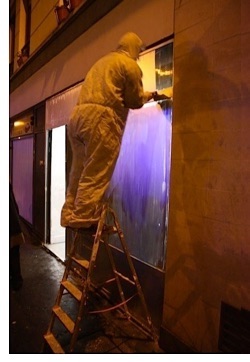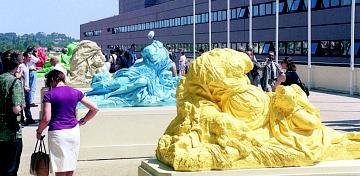Orion Giret: Après la création René Denizot |
Paradoxically, Giret's painting has no theater, no space set aside, no privileged place. It has no image before it is played. It has no story before it is exposed. It represents nothing before its own presence. It presents itself arbitrarily. There is, here and now, a present of painting - which nothing anticipates or prefigures, which neither culture or nature predetermines. There is the arbitrary beginning that the artifice of painting inaugurates. It is a beginning without history. It cuts pictorial tradition short, it abandons its domination, its knowledge, its schools, its territories and its succession, it gives them all up to the history of art. It comes after the mastery of space on a surveyor's picture-plane, after the death of time in an oblivion locked into the frame, after the effacement of painting in the mirror of creation . After the exhaustion of pictorial art in the infinite reproduction of the already-seen, the abandonment of painting to the world begins. Painting without reference to God, without reference to Man, without reference to Nature. Painting without representation, nor any concept of art, nor any notion of things in themselves. The abandonment is groundless, without fundament. It is more vital than pictorial. It leaves the vanity of artifice to painting. It leaves the vacuity of space and time to the world. Without the protection of the frame, without the support of a panel, the armature of a stretcher, the veil of a canvas, painting is abandoned to the world. The world is left to this local and momentary covering, to the erratic and methodical inscription of pointing. Painting is given over to the signal clarity of its Material being, as a point of view on a possible world. Painting and world are wed, as if there were nothing to it: as if the fiction of possibility were born from this encounter, as if their meeting bodied forth the image that inaugurates the world. Giret's painting springs from this beginning with no reserve, this exhibition without fundament, this entry into matter without background or backstage, this fiction without trompe-l'oeil, this vision without object of representation, this point of view without any subject of perceive, this material structure of perception, this surface presentation of space and time, this experience with no refuge from the here and now. Materially, painting begins with the election of space and time. Painting is not in space like a picture in its frame. It is not in time like an image frozen on a screen. Painting is the spacing of the place that it situates. It is the present of the time that gives it rise. It is the moment and the place where space and time take body, where they become visible and tangible, where they are experienced physically as the space and time of appearance, as the thresholds and limits of an entry into matter. Focal points of evanescent dwellings, nomadic flames, bursting apparitions where each appearance is a sign of disappearance, where in the blink of an eye, viewpoint and vision are exposed: exposing the transitory reality of a world half-seen, exposing it to fiction, to fission, to the infraction of the possible. Painting flush with the world: not the world beyond the pale, fixed in a frozen image, but the space and time of a gambol into the world. Paint the gambol. Gamble painting on the play of the world. Play the moment and the place where the world makes an image and the image comes into the world. Expose the world's passage to the image, and the passage of the image to the world. Change nothing: wed the world and the image. Risk a change-up, render the exchange of reality and fiction that is possible here and now. Experience the seduction of one and the other. Expose the infraction, open up your heart. Painting means the amorous encounter of here and now. It gives it body. Painting is a methodical approach, it is the real and material practice of appearance, giving matter and form, color and flesh, to space and to time. It exposes the concrete emergence, renders it present in space and in time: pigment's body, the viewpoint and the fragmentary vision, the infraction of the world into here and now. As though the world were born to the world in an instant, in form and color, in the flesh and fashion of the here and now. The turning of the here-now, the revolution of space and time around the event that brings them out and gives them body: this is what empties places and frees the present, at the very instant when pointing becomes the phenomenon and the method of their emergence to the world, of their advent Painting weds the world and becomes its skin, in the inaugural seduction of the here-now. Painting covers and reveals, penetrates and exposes. It is neither a window opened, nor a curtain closed. It adheres to the world, it surfaces in it. It signs it without signifying it. By entering the world, it puts the world beside itself. It is cosmic cosmetics, impressed with appearances. It incriminates the appearance of reality. It exposes the reality of appearance The process of Giret's painting institutes the trial of appearances. It is convened by the immediate and apparent reality of the world projecting itself upon it, inscribing itself within it. Here it has its body. It seizes hold of the image. It projects it into the world. It inscribes apparent reality with the viewpoint and the vision of the image. Materially, here and now it provokes the appearance or disappearance of a moment and a place for the identification of a reality - an elective and effective reality, but one which, here and now, also brings the differentiation of moments and places into play for the election of other realities. Painting returns an image to reality, the image that was blinded. It returns a reality to the image, a reality illuminated. It returns the inference, the reference and the difference of image and reality to the present. It projects one and the other, one into the other. There is no retrospection, there is retroprojection: the reciprocal project of a world, in the image and in reality, in the work and its unworking, in the place and the moment of the encounter that painting incarnates and exposes, here and now. In the apparent continuity of the real (architectured, installed, edified on the blind image of permanence and immutability, like the mirror of a creation played out in advance), in the reified representation of bony concepts and wooden words, Giret's painting introduces a break, a discontinuity. It coaxes out an appearance of the risk and the interstice, of the fiction at work on the fissured relief of reality. In living opposition to a cadastral claim on the exquisite cadaver of the real, pointing begins by wedding the world in the present, where it is possible, where the facture of possibility meets the fracture of the here-now. Like the crests of waves, the horizon described by Giret's painting is continuous and broken, closed and open a fault line full and empty: the reinstigated prowess of space and time, wake and prow of the here and now, underscoring and overwriting the undecidable and decisive gap between the world and representation. Ii is the horizon of the possible, of its fiction and its infraction, a horizon that sea level never attains. Here, pointing flows, is applied, is exposed, continually engendering discontinuous views, each the viewpoint and the vision of a real which, though it may not be identified to a unique and total image of reality, is nonetheless an exposure of the world, exhibiting c potential world, exposing its free play The ephemeral life of Giret's works, their working life, is not a matter of dates, of contracts and locations. It is the condition of an oeuvre as the operation of space and time. The work a work produces the space and time of its exhibition. It is the moment and the place that it exposes. It is the vehicle and the generational field of appearance and disappearance, of its birth and death, of its beginning and end, o its present situation, of its existence here and now. It is the fable and the generative grammar of the reality and fiction that it brings into the world, that it brings into play. Reality is not definitive, it is yet to be defined. Fiction is never just given, it is here to be interpreted. Within this double play painting takes place. The work of painting defines and interprets a score, a musical repartition o the world. It is the work of a moment and a place, the work of a possible world. It is a participation in the free play of the world. It is waiting to be played over and over again. |
| René Denizot, Directeur adjoint de l'ENSAPC Translated by Jeff Rian | in French: rene_denizot_giret.html |


